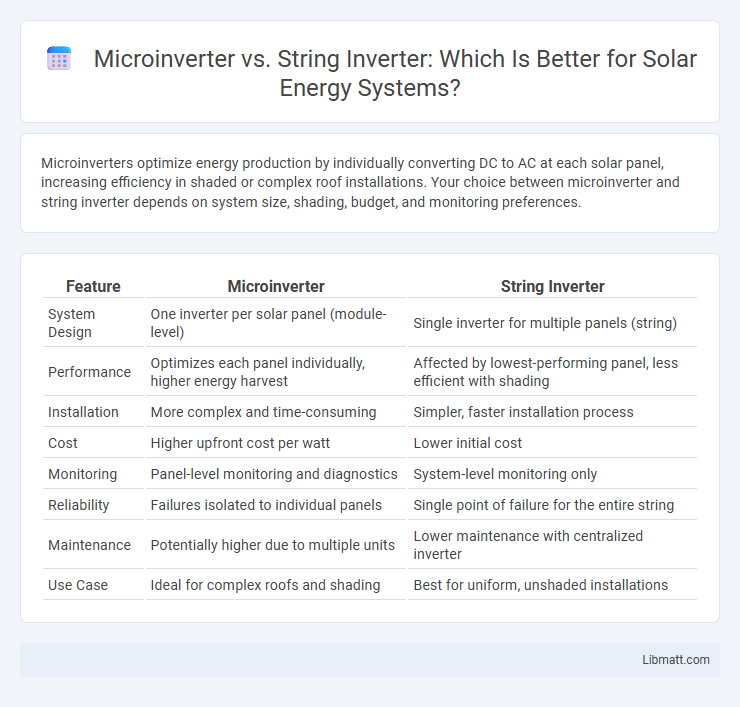Microinverters optimize energy production by individually converting DC to AC at each solar panel, increasing efficiency in shaded or complex roof installations. Your choice between microinverter and string inverter depends on system size, shading, budget, and monitoring preferences.
Table of Comparison
| Feature | Microinverter | String Inverter |
|---|---|---|
| System Design | One inverter per solar panel (module-level) | Single inverter for multiple panels (string) |
| Performance | Optimizes each panel individually, higher energy harvest | Affected by lowest-performing panel, less efficient with shading |
| Installation | More complex and time-consuming | Simpler, faster installation process |
| Cost | Higher upfront cost per watt | Lower initial cost |
| Monitoring | Panel-level monitoring and diagnostics | System-level monitoring only |
| Reliability | Failures isolated to individual panels | Single point of failure for the entire string |
| Maintenance | Potentially higher due to multiple units | Lower maintenance with centralized inverter |
| Use Case | Ideal for complex roofs and shading | Best for uniform, unshaded installations |
Introduction to Solar Inverters
Solar inverters convert direct current (DC) from solar panels into alternating current (AC) for home use, with microinverters and string inverters being the two primary types. Microinverters attach to individual panels, optimizing performance and allowing panel-level monitoring, while string inverters manage a group of panels together, offering cost-efficiency for uniform solar arrays. Understanding the distinctions helps tailor solar system design to specific energy needs and installation conditions.
What is a Microinverter?
A microinverter is a compact electronic device installed on each solar panel to convert direct current (DC) into alternating current (AC) at the source. Unlike string inverters that handle multiple panels simultaneously, microinverters optimize performance individually, improving energy harvest and reducing the impact of shading or panel mismatch. This technology enhances overall system efficiency and reliability in residential and commercial solar installations.
What is a String Inverter?
A string inverter is a central device that converts direct current (DC) generated by a series of solar panels connected in a "string" into alternating current (AC) used by household appliances. It optimizes performance at the string level, meaning shading or damage to one panel can reduce the output of the entire string. Commonly used in residential and commercial solar systems, string inverters offer cost-effective energy conversion but less granular monitoring compared to microinverters.
Key Differences Between Microinverters and String Inverters
Microinverters are attached to individual solar panels, optimizing each panel's output independently, while string inverters connect multiple panels in series, converting DC to AC power for the entire string. Microinverters improve energy harvest from shaded or mismatched panels, offering enhanced monitoring and reliability, whereas string inverters are typically more cost-effective for uniform installation sites. The choice between microinverters and string inverters impacts system efficiency, installation complexity, and maintenance requirements.
Efficiency Comparison: Microinverter vs String Inverter
Microinverters generally provide higher overall system efficiency by optimizing power output at the individual panel level, reducing losses caused by shading or panel mismatch. String inverters, while typically offering slightly lower efficiency, are cost-effective for uniform, unshaded solar arrays and benefit from simpler maintenance. Studies show microinverters can achieve up to 5-10% greater energy harvest in real-world conditions compared to string inverters.
Installation and System Design Flexibility
Microinverters enable individual panel installation, offering greater system design flexibility and easier scalability for diverse roof layouts. String inverters require panels to be connected in series, limiting design options and making shading or panel mismatch a significant issue. The modular nature of microinverters supports simplified installation and optimized energy harvest in complex or shaded environments.
Cost Analysis: Initial Investment and Maintenance
Microinverters typically have a higher initial investment compared to string inverters due to individual unit costs for each solar panel. Maintenance costs for microinverters can be lower over time since issues are isolated to specific panels, reducing system-wide downtime. String inverters offer lower upfront expenses but may incur higher maintenance costs when failures affect the entire string, requiring full inverter replacement or extensive troubleshooting.
Performance in Shaded or Complex Roof Conditions
Microinverters optimize the performance of each individual solar panel, making them highly effective in shaded or complex roof conditions where panels receive uneven sunlight. String inverters connect multiple panels in series, causing the entire string's output to drop if one panel is shaded or underperforming. Your solar system's efficiency improves with microinverters by maximizing energy harvest from partially shaded or irregularly oriented panels.
System Monitoring and Troubleshooting
Microinverters offer granular system monitoring by tracking performance at the individual panel level, enabling precise identification of issues for faster troubleshooting. String inverters provide monitoring at the string level, which can make pinpointing specific panel problems more challenging and time-consuming. Your system's efficiency and maintenance ease improve significantly with microinverter setups due to their detailed diagnostic capabilities.
Which Inverter is Best for Your Solar Energy Needs?
Microinverters provide more efficient energy conversion for individual solar panels, optimizing performance and minimizing the impact of shading or panel mismatch, making them ideal for complex roof layouts or partial shading conditions. String inverters are more cost-effective for larger, uniform solar arrays and offer easier maintenance with centralized control, suited for straightforward installations with consistent sunlight exposure. Choosing the best inverter depends on your system size, roof complexity, shading patterns, and budget considerations.
Microinverter vs String Inverter Infographic

 libmatt.com
libmatt.com